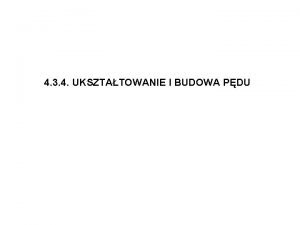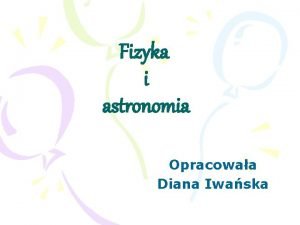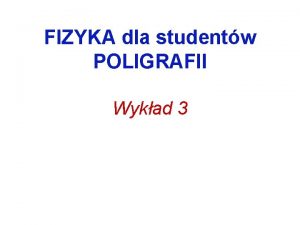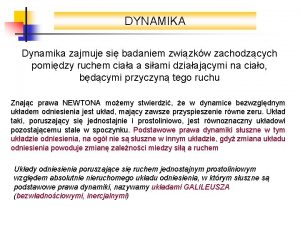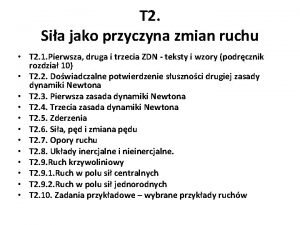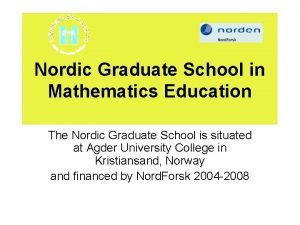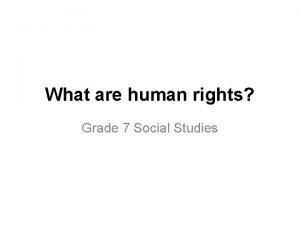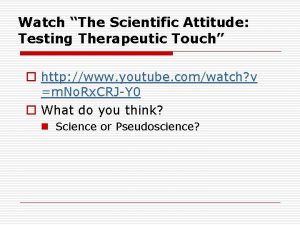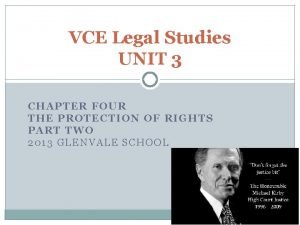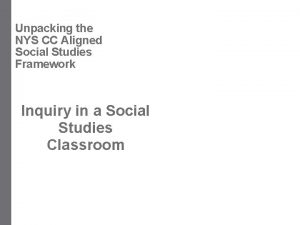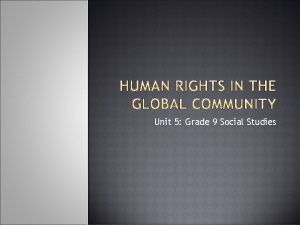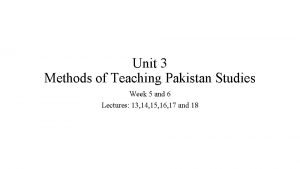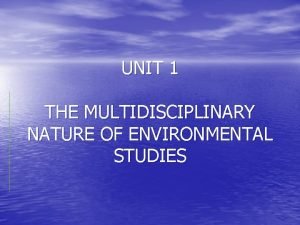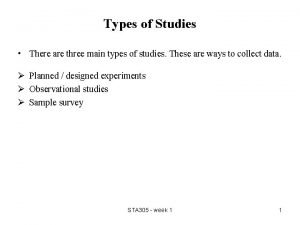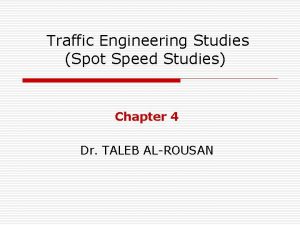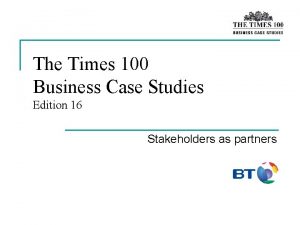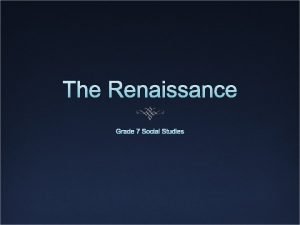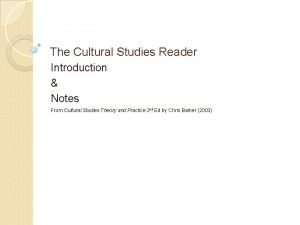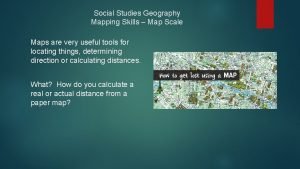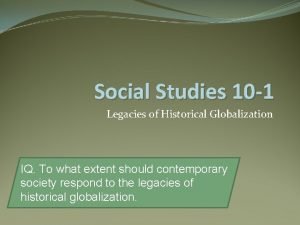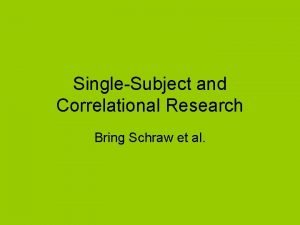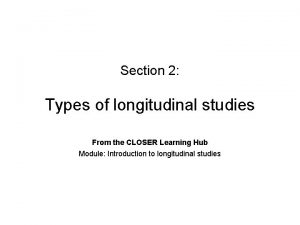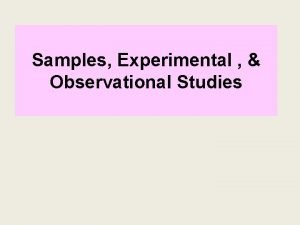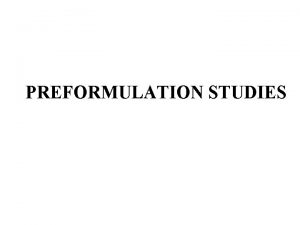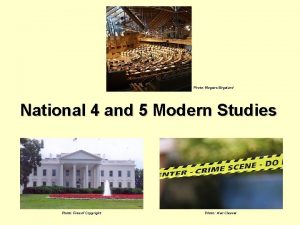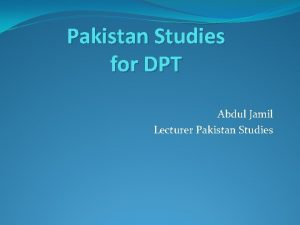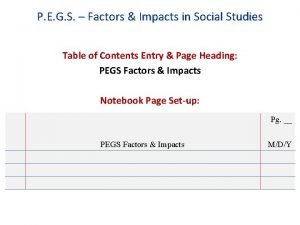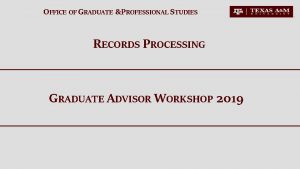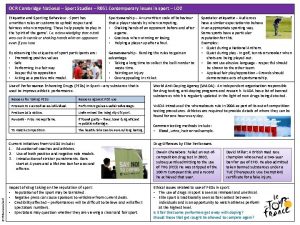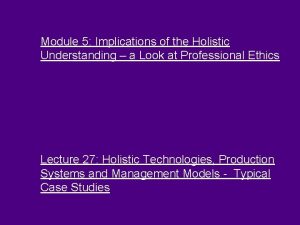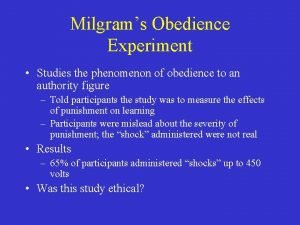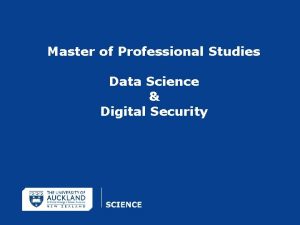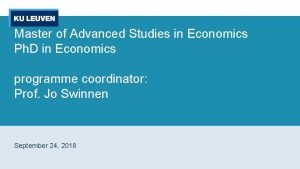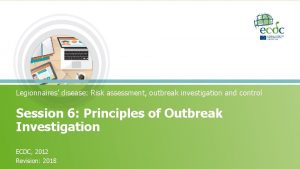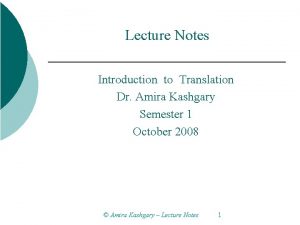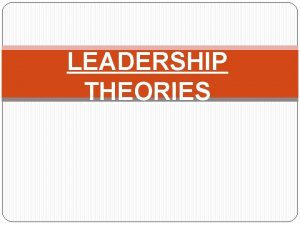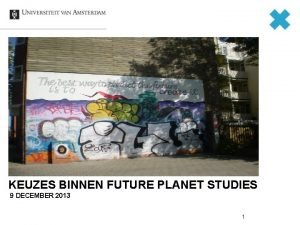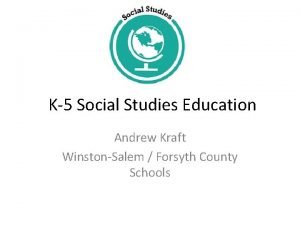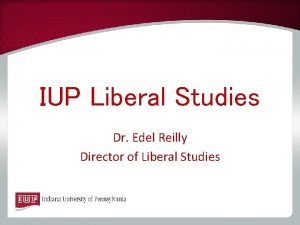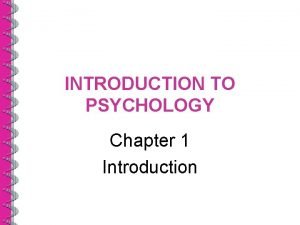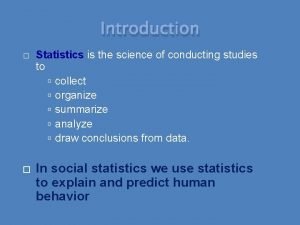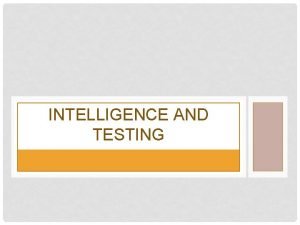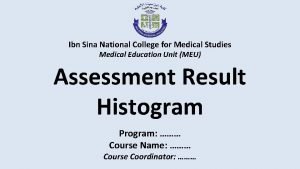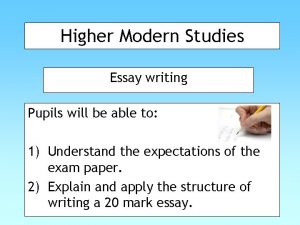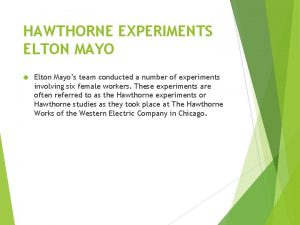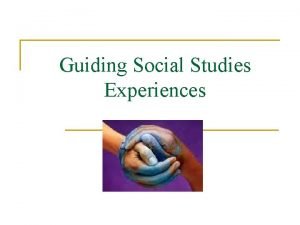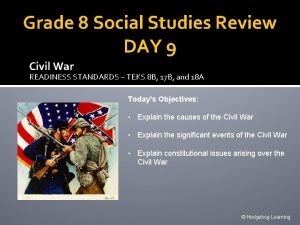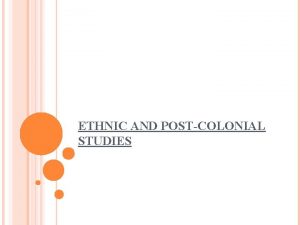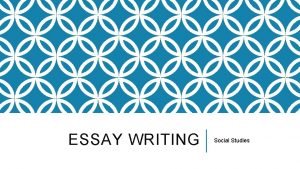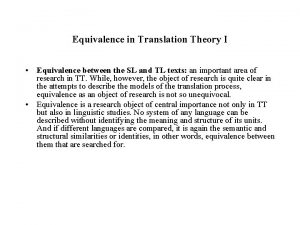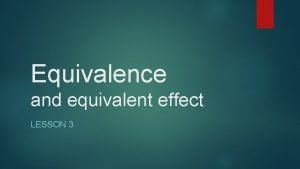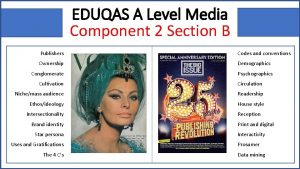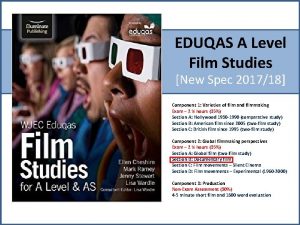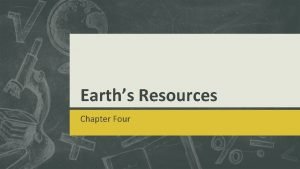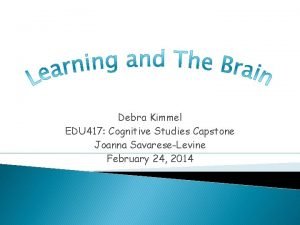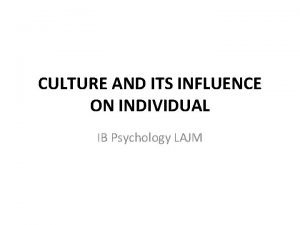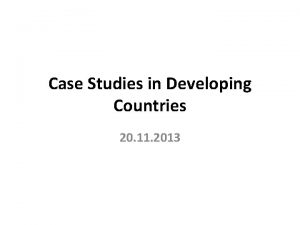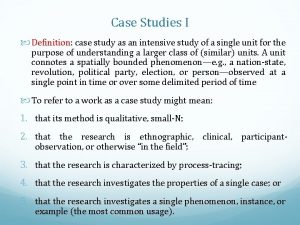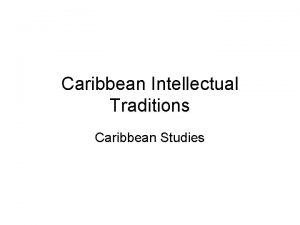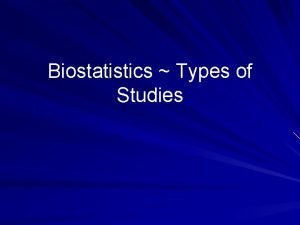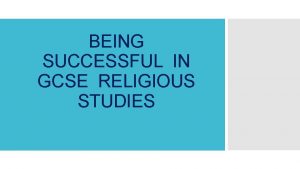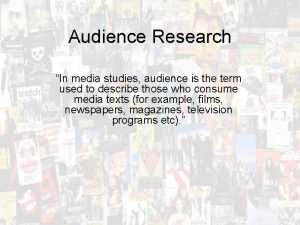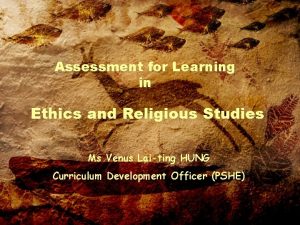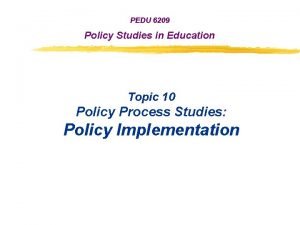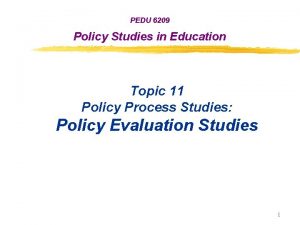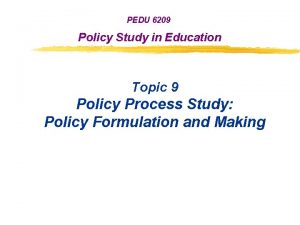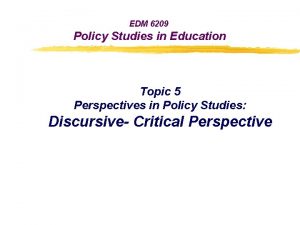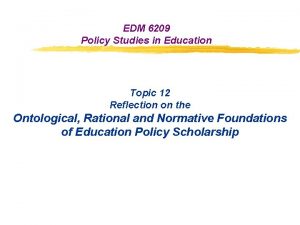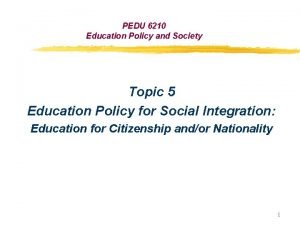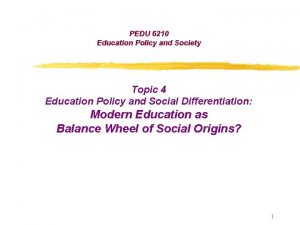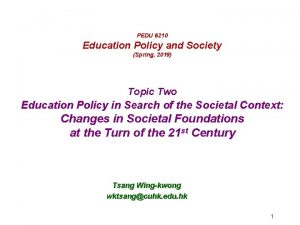PEDU 6209 Policy Studies in Education Topic 8






























































































































- Slides: 126

PEDU 6209 Policy Studies in Education Topic 8 The Normative Context of Policy Studies: Policy as Value Paradox

The Value Dimension of Policy Studies in Education z Stephen Ball indicates that “Policy is clearly a matter of the ‘authoritative allocation of values’; policies are the operational statements of values, ‘statements of prescriptive intent’ (Kogan 1975 p. 55). But values do not float free of their social context. We need to ask whose values are validated in policy, and whose are not. Thus, The authoritative allocation of values draws our attention to the centrality of power and control in the concept of policy’ (Prunty 1985 p. 135). Policies project images of an ideal society (education policies project definitions of what counts as education). ”(Ball, 1990, p. 3; my emphases)

The Value Dimension of Policy Studies in Education z Emile Durkheim, one of the founding fathers of sociology, asserted in the first decade of the twentieth century, “Each society sets up a certain idea of man, of what he should be, as much from the intellectual point of view as the physical and moral; that this ideal is, to a degree, the same for all the citizens; that beyond a certain point it becomes differentiated according to the particular milieux that every society contains in its structure. …

The Value Dimension of Policy Studies in Education z Emile Durkheim “…. . It is this ideal, at the same time one and various, that is the focus of education. Its function, then, is to arouse in the child: (1) a certain number of physical and mental states that the society to which he belongs considers should not be lacking in any of its members; (2) certain physical and mental states that the particular social group (caste, class, family, profession) considers, equally, ought to be found among all those who make it up. (Durkheim, 2006/1911, p. 79 -80; my emphasis)

The Value Dimension of Policy Studies in Education z “The purpose of education, according to Aristotle, is to reproduce in each generation the ‘type of character’ that will sustain the constitution: a particular character for a particular constitution. But there are difficulties here. The members of society are unlikely to agree about what the constitution , in Aristotle’s broad sense, actually is, or what it is becoming, or what it should be. Nor are they likely to agree about what character type will best sustain it or how that type might best be produced. ” (Walzer, 1983, P. 197)

The Value Dimension of Policy Studies in Education z What are the values and ideals that education policy strives to attained?

Value Inquiry: An Integral Part of Policy Studies of Education z What is value? How to enquire it? y D. N. Aspin’s formal definition of value: “Conduct, performances, situations, occurrence, states of affairs, production, all these is associated with the ways in which we perceive them, appraise them, judge them, and the way we are inclined towards or away from, attract to or repelled by. We choose them. We prefer them over other things in the same class of comparison. We want to follow their model or to replicate them. We want to emulate them. ” (Aspin, 1999, p. 125) Simply put, value is the attributes endowed in an object which we find attractive, appreciative, desirable, adorable, pleasurable, etc.

Value Inquiry: An Integral Part of Policy Studies of Education z What is value? How to enquire it? However, these desirable attributes may entail different understanding by different perspective in value inquiry.

Value Inquiry: An Integral Part of Policy Studies of Education z What is value? How to enquire it? y. Hedonistic emotivist’s understanding: Value can be construed simply as physical and/or psychological pleasures and enjoyments which a person experiences from the encounter of a state of affair, an object, a situation, or other persons. (Mac. Intyre, 2007, 11 -12)

Value Inquiry: An Integral Part of Policy Studies of Education z What is value? How to enquire it? y. Pragmatic and instrumental understanding: From the perspective of pragmatism, any state of affairs or objects will be taken as valuable as long as they can bring about desirable outcomes. In short, they are any effective and efficient means, which fit with the practical calculation of instrumental rationality. (Taylor, 1985, Pp. 21 -23) This kind of value has been commonly called extrinsic value. “An extrinsic value is valuable not for its own sake, but because it facilitates getting or accomplishing something that is valuable for its own sake. ” (Ellis, 1998, p. 12)

Value Inquiry: An Integral Part of Policy Studies of Education z What is value? How to enquire it? y. Reflective and critical understanding: It refers to the evaluation which goes beyond the criteria of quantitative calculations of outcome. Instead, the state of affair under evaluation is critically assessed to see whether they possess some qualitative distinctions of good or worth of its own. Furthermore, the criteria of evaluation in use may also reflectively relate to the well-beings, mode of life or kind of person that the persons concerned ought to lead. (Taylor, 1985; Dworkin, 1995) This kind of value has commonly called intrinsic value

Value Inquiry: An Integral Part of Policy Studies of Education z Constituents of critical and “strong” evaluation: Charles Taylor has coined the term “strong evaluation” to kind of value inquiry which aims to substantiate an attribution of an intrinsic value to a state of affair, an object and even a person. He has outlined the numbers of constituents for such a strong-evaluation inquiry. (Taylor, 1985; see also Dworki, 1995)

Value Inquiry: An Integral Part of Policy Studies of Education z Constituents of critical and “strong” evaluation: …. y Justificatory with articulacy and depth: The first constituent of a strong evaluation is that the evaluation must be supported with explicitly articulated justifications. Furthermore, these justifications must be grounded on ethical, moral and/or political validities and “depth”.

Value Inquiry: An Integral Part of Policy Studies of Education z Constituents of critical and “strong” evaluation: …. y. Supported with sense of responsibility and agency: A strong evaluative assertion must also be supported with human practices and actions, i. e. human agencies. Furthermore, those who are in support of the strong evaluative positions are not just paying lip services but are ready to bear the cost or even lost for its fulfillment

Value Inquiry: An Integral Part of Policy Studies of Education z Constituents of critical and “strong” evaluation: …. y. Embodied with notion of identity: A person who are in support of a strong evaluative stance are most probably hold that value orientation continuously over time, consistently in various circumstances and coherently with the other aspects of his life. In other word, the value orientation becomes part of his own identity.

Value Inquiry: An Integral Part of Policy Studies of Education z Constituents of critical and “strong” evaluation: …. y. Embedded in community: The last constituents of strong-evaluation inquiry is to look beyond human agency or identity but into human community, which may be defined as a group of human agents who share and identify with a particular value stance. In other words, the strong and intrinsic value in question has been embedded into the lifeworld of a community.

Value Inquiry: An Integral Part of Policy Studies of Education z Levels of value inquiry: Ronal Dworkin has made a distinction between three levels of value. He suggests that “ethnics studies how people best manage their responsibility to live well, and personal morality what each as an individual owes other people. Political morality, in contrast, studies what we all together owe others as individuals when we act in and on behalf of that artificial collective person. ” (Dworkin, 2011, Pp. 327 -8) Accordingly, value can be categorized into …


Value Inquiry: An Integral Part of Policy Studies of Education z Levels of value inquiry: … y. Ethical value: It refers to desirable traits and features we attributed to human behaviors, actions, and conducts. y. Moral value: It refers to desirable traits and features attributed to human interactions and relationships among fellows humans. y. Political values: It refers to the ethical and moral values taken by a given society as of prominent importance that they should be imposed onto all members of that society coercively.

Value Inquiry: An Integral Part of Policy Studies of Education: A Summary Valuation by Articulacy & Depth Ethical value on individual basis Moral value on interpersonal basis Political value on sociopolitical basis Valuation agency & Sense of Obligation Valuation by selfidentification Valuation by Social Identification

Value Inquiry: An Integral Part of Policy Studies of Education z Accordingly, value inquiry in public policy studies may be defined as part of the inquiry of political value which focuses on the legitimacy of a public authority (the modern state) in substantiating those prominent values, which are to be imposed coercively onto the civil society which falls under its sovereignty. This line of inquiry falls mainly within the purview of political philosophy and jurisprudence.

Policy Discourse of “Quality Education”: In Search of the Intrinsic Value

Policy Discourse of “Quality Education”: In Search of the Intrinsic Value z Techno-efficient conception of quality education y. Quality education outcome: Acquisition of x. Skills and competences, which can be standardized, quantified, calculable, predictable and controllable x. Skills and competences, which are employable, marketable and convertible in money terms x. Skills and competences, which are governable y. Quality learning and teaching processes x. Students are materials, which can be value-added x. Teachers are workers, who can be benchmarked x. Teaching and learning are processes, which can be audited in “time-motion” terms

Policy Discourse of “Quality Education”: In Search of the Intrinsic Value z Techno-efficient conception of quality education y. Quality school organizations x. School organizations are structures, which can be standardized and benchmarked x. School organizations are processes, which can be audited with standardized indicators x. School organizations are cultures, which can be measures with school ethos checklists y. Assumption of prefect causality in education enterprises in techno-scientific conception of quality in education

Policy Discourse of “Quality Education”: In Search of the Intrinsic Value z Empathetic-practical conception of quality in education y. Quality in education outcome: Attainment of x. Practical efficacy in interaction with fellow beings x. Empathetic understanding in social interactions x. Social identification and integration in particular human communities

Policy Discourse of “Quality Education”: In Search of the Intrinsic Value z Empathetic-practical conception of quality in education y. Quality in learning and teaching processes x. Teachers as professionals working in communal bonds of intellectuality, practicality and trust x. Teachers and students are in professional-client relationships, which are bonded by empathetic understanding and trust x. Teaching and learning are practical interactions of uncertainty, which can not be lock-stepped into calculable and controllable processes

Policy Discourse of “Quality Education”: In Search of the Intrinsic Value z Empathetic-practical conception of quality in education y. Quality in school organizations x. Schools as communities of empathetic understanding and caring between the elderly and offspring x. Schools as professional communities of intellectuality, practicality and trust y. Assumption of education as an uncertain practice of Reflective Practitioners (Schon, 1983)

Policy Discourse of “Quality Education”: In Search of the Intrinsic Value z Emancipatory conception of quality in education y. Quality in education outcome: Capacities to x. To excel beyond the current state of being x. To speculate x. To better the status quo y. Quality in learning and teaching processes x. Teachers are transformative intellectuals working for the betterment of the status quo and the coming generation x. Students are potentials to be excel x. Teaching and learning are experimental, surprising and risktaking processes of liberating speculative spirits

Policy Discourse of “Quality Education”: In Search of the Intrinsic Value z Emancipatory conception of quality in education y. Quality in school organizations x. Schools as liberating communities of human potentials x. Schools as communities of praxis y. Assumption of education as risk-taking praxis of speculative or even revolutionary spirits

Equality as Prima Facie Value in Education Policy Argumentation z Policy search for equality of education: The US experiences y Horace Mann, one of the founders of US public school system, advocated three century ago, “Surely nothing but universal education can counterwork this tendency to the domination of capital and servility of labour. If one class possesses all the wealth and the education, while the residue of society is ignorant and poor, it matters not by what name the relation between them may be called: the latter, in fact and in truth, will be the servile dependents and subjects of the former. But, if education be equally diffused, it will draw property after it by the strongest of all attractions. . Education, then, beyond all other devices of human origin, is the great equalizer of the conditions of men, the balance-wheel of the social machinery. ” (Horace Mann, 1848)

Equality as Prima Facie Value in Education Policy Argumentation 1. Policy search for equality of education: The US experiences James S. Coleman (1926 -1995) Horace Mann (1796 -1859)

Equality as Prima Facie Value in Education Policy Argumentation z Policy search for equality of education: The US experiences y. James Coleman’s conceptualization of equality of educational opportunity x. Equality of access to education x. Equality of educational process x. Equality of educational result x. Equality of educational outcome

Equality as Prima Facie Value in Education Policy Argumentation z Douglas Rae’s structural grammar of equality =

Equality as Prima Facie Value in Education Policy Argumentation z Douglas Rae’s structural grammar of equality y. Formal Definition “ = ” y. Grammar of equality: As formal definition of equality applies to concrete social situations, it has to adopted to at least five structural problems and “these problems must be anticipated wherever equality is a goal or principle of social policy. They are: (1) complex social classification, (2) plural allocation, (3) indivisibilities, (4) human differences, and (5) relativity. ” (Rae, 1981, p. 14)

Equality as Prima Facie Value in Education Policy Argumentation z Douglas Rae’s structural grammar of equality y. Subject of equality: Equality for whom x. Individual-regarding equality • Simple subject • Segmental subject (= ≠ =) x. Bloc-regarding equality: Bloc-equal subject (≠ = ≠) y. Domain of equality - Equal what? Do X's domain of allocation (supply) cover Y's domain of account (demand) x. Straightforward equality x. Marginal equality x. Global equality

Equality as Prima Facie Value in Education Policy Argumentation y Objective of equality x. Direct equality (of result) x. Equality of opportunity • Means-regarding equal opportunity • Prospect-regarding equal opportunity y Value of equality x. Lot-regarding equality x. Person-regarding equality • Utility-based equality • End based equality • Need-based equality y Relativity of equality x. Absolute equality x. Relative equality

Equality as Prima Facie Value in Education Policy Argumentation z Application of Rae’s structural grammar equality on education y. Classification of students x. Simple individual equality: Universal, free and compulsory education x. Segment-subject equality: Special education x. Block-regarding equality: Positive-discrimination education for racial minorities, the socioeconomic disadvantaged and female y. Distribution of educational resources x. Marginal equality: 9 -year compulsory education x. Global equality: Positive discrimination education

Equality as Prima Facie Value in Education Policy Argumentation z Application of Rae’s structural grammar equality on education y. Equality of educational opportunity rather result x. Means-regarding equality of educational opportunity • Equality of educational access • Equality of education process x. Prospect-regarding equality of educational opportunity • Equality of education output • Equality of education outcome

Equality as Prima Facie Value in Education Policy Argumentation y. Equality of educational value x. Lot-regarding equality of education: Principle of respect, compulsory education common-school and common-curriculum policies x. Personal-regarding equality of education: • Utility-based personal-regarding equality of education • End-based personal-regarding equality of education • Need-based personal-regarding equality of education • Principle of praise and fair educational sifting and selection y. Relativity of equality x. Absolute educational equality x. Relative educational equality

Subject of Equality Simple subject equality = Segment subject equality Domain of Equality Objective of Equality Straightforward equality Value of Equality Lot. Regarding equality Direct equality (for result) Utilitybased equality Meanregarding equal opportunity Marginal equality Relativity of Equality Absolute equality Endbased equality Blocregarding equality 3 X = 216 Prospectregarding equal opportunity Global equality 3 x 3 Needbased equality x 4 Relative equality x 2

Justice as Prima Facie Value in Education Policy Argumentation z Aristotle's formal definition of justice (Aristotle, 1996, Book III, P. 61 -91) y. Treating equally or treating unequally is just. y. Treating equal unequally or treating unequally is unjust.

Justice as Prima Facie Value in Education Policy Argumentation z John Rawls’ A Theory of Justice (1921 -2002)

Justice as Prima Facie Value in Education Policy Argumentation z John Rawls’ A Theory of Justice y Justice as fairness: The meaning of fairness that Rawls reckons is as follows “Fundamental to justice is the concept of fairness which relates to right dealing between persons who are cooperating with or competing against one another, as when one speak of fair games, fair competition, and fair bargains. The question of fairness arises when free persons, who have no authority over one another, are engaging in a joint activity and among themselves settling or acknowledging the rules which define it and which determine the respective shares in its benefits and burdens. …. .

Justice as Prima Facie Value in Education Policy Argumentation z John Rawls’ A Theory of Justice y The meaning of fairness … “…A practice will strike the parties as fair if none feels that, by participating in it, they or any of the others are taken advantage of, or forced to give in to claims which they do not regard as legitimate. This implies that each has a conception of legitimate claims which he thinks it reasonable for others as well as himself to acknowledge. …A practice is just or fair, then, when it satisfies the principles which those who participate in it could propose to one another for mutual acceptance under aforementioned circumstances. ” (Rawls, 1999[1958], p. 59)

Justice as Prima Facie Value in Education Policy Argumentation z John Rawls’ A Theory of Justice y Two principles of justice: Rawls stipulates that “justice is the first virtue of social institution” (P. 3) and “the primacy of justice” over other social values. Hence, the basic structure of a just society is to be constituted in accordance with “the two principles of justice”. x “First Principle: Each person is to have an equal right to the most extensive total system of equal basic liberties compatible with similar system of liberty for all. x “Second Principle: Social and economic inequalities are to be arranged so that they are both • to the greatest benefits of the least advantaged, …and • attached to offices and positions open to all under conditions of fair equality of opportunities. ” (Rawls, 1971, p. 302)

Justice as Prima Facie Value in Education Policy Argumentation z Applications of the principles: “These principles primarily apply …to the basic structure of society. They are to govern the assignment of rights and duties and to regulate the distribution of social and economic advantages…. These principles presuppose that the social structure can be divided into two more or less distinct parts. ” (Rawls, 1871, p. 61)

Justice as Prima Facie Value in Education Policy Argumentation z Applications of the principles: … y The First Principle applies to those distinct “aspects of the social system that define and secure the equal liberties of citizenship. …The basic liberties of citizens are, roughly speaking, political liberty (right to vote and to be eligible for public office) together with freedom of speech and assembly; liberty of conscience and freedom of thought; freedom of person along with right to hold (personal) property; freedom from arbitrary arrest and seizure as defined by the concept of the rule of law. These liberties are all required to be equal…, since citizens of just society are to have the same basic rights. ” (p. 61)

Justice as Prima Facie Value in Education Policy Argumentation z Applications of the principles: … y. The Second Principle applies to those aspects of social system “that specify and establish social and economic inequalities. ” More specifically, it “applies…to the distribution of income and wealth and to the design of organizations that make use of differences in authority and responsibility, or chains of command. ” (p. 61)

Justice as Prima Facie Value in Education Policy Argumentation z Interpretation of the second principle y. Rawls qualifies that the two constituent phrases in the Second Principle, namely to “everyone’s advantage” and “equally open to all” need further interpretation. y. Rawls interprets the two phrases as follows (Rawls, 1971, p. 65)

Justice as Prima Facie Value in Education Policy Argumentation

Justice as Prima Facie Value in Education Policy Argumentation z Priority and lexical orders between principles of justice y. The priority of liberty: The First Principle, namely the principle of liberty) has lexical priority over the Second Principle: This ordering means that a departure from the institutions of equal liberty required by the first principle cannot be justified by, or compensated for, by greater social and economic advantages. ” (p. 61) y. The priority of democratic equality over the other three systems, in other words, the priority of difference principle and equality as equality of fair opportunity over principle of efficiency and equality as careers open to talent.

Justice as Prima Facie Value in Education Policy Argumentation z Michael Walzer’s concept of complex equality: Walzer, a prominent political philosopher in the US, published a book entitle Spheres of Justice in 1983, to criticize Rawls’ ambition to construct a, if not the, theory of justice and at the same time outline his theory of complex equality and spheres of justice.


Justice as Prima Facie Value in Education Policy Argumentation z Walzer’s concept of complex equality: y Pluralistic conception of distributive justice: x Walzer begins with the argument that “to search for unity is to misunderstand the subject matter of distributive justice. ” (Walzer 1983, P. 4)

Justice as Prima Facie Value in Education Policy Argumentation z Walzer’s concept of complex equality: y Pluralistic conception of distributive justice: … x Instead he underlines, “Different political arrangements enforce, and different ideologies justifiy, different distributions of membership, power, honor, ritual eminence, divine grace, kinship and love, knowledge, wealth, physical security, work and leisure, rewards and punishments, and a host of goods more narrowly and materially conceived―food, shelter, clothing, transportation, medical care, commodities of every sort, and the odd things (printings, rare books, postage stamps) that human beings collect. And this multiplicity of goods is matched by a multiplicity of distributive procedures, agents, and criteria. ” (Walzer, 1983, P. 3)

Justice as Prima Facie Value in Education Policy Argumentation z Walzer’s concept of complex equality: y. Membership of distributive community: According to Walzer’s formulation distribution could only take place within definitive community and distribution could also be undertaken among eligible and entitled members. x. In his own words, “human society is a distributive community. …It is important that: we come together to share, divide, and exchange. We also come together to make things that are shared, divided, and exchanged; but that very making―work itself―is distributed among us in a division of labor. ” (Walzer, 1983, P. 3)

Justice as Prima Facie Value in Education Policy Argumentation z Walzer’s concept of complex equality: y. Membership of distributive community: … x Accordingly, the first and most important question in distributive justice is: How is the distributive community is constituted? Who are members who are entitled to share, divide, and exchange? Who are the non-members who are excluded from the distributive game? In short, how membership is defined?

Justice as Prima Facie Value in Education Policy Argumentation z Walzer’s concept of complex equality: y. Membership of distributive community: … x. Walzer has listed a matrix of membership commonly found in human society for our reference. • • • enemy, stranger, refugee, guest worker, resident in a territory, citizen of a sovereign state, national of a nation, member of ethnic group, neighbor, clansman, family member, etc.

Justice as Prima Facie Value in Education Policy Argumentation z Walzer’s concept of complex equality: y. Membership of distributive community: … x. Walzer underlines that “the distribution of membership is not pervasively subject to the constraints of justice. ” (Walzer, 1983, P. 61) In fact, throughout human history, we have witnessed numerous arbitrary and accidental assignments of membership among socioeconomic, political and cultural communities.

Justice as Prima Facie Value in Education Policy Argumentation z Walzer’s sphere of education and its principles of distributive justice y. Education as a special and enclosed sphere: Education is “what John Dewey called a ‘special environment’. The students are granted a partial moratorium from the demand of society and economy. The teachers, too, are protected from the immediate forms of external pressure. They teacher the truths they understand, and the same truths, to all the students in front of them, and respond to questions as best they can, without regard to the students’ social origins. ” (Walzer, 1983, P. 199)

Justice as Prima Facie Value in Education Policy Argumentation z Walzer’s sphere of education and its principles of distributive justice… y. According, “the most interesting and hardest distributive questions” arising from the sphere of education are: “Which children is it who are admitted into the enclosed communities? Who goes to school? And to what sort of school? (What is the strength of the enclosure? ) To study What? For how long? With what other students? ” (Walzer, 1983, P. 199)

Justice as Prima Facie Value in Education Policy Argumentation z Walzer’s sphere of education… y As a results, there have been various kinds of schooling developed according to diverse principles of distributive justice x. Common schools for all: As Aristotle advocated centuries ago “the system of education in a state must … be one and the same for all, and the provision of this system must be a matter of public action. ” (Aristotle, Politics; quoted in Walzer, 1983, P. 202; my emphasis) And again as R. H. Tawney, a prominent historian and socialist in the twentieth-century England, underlined, “To serve educational needs, without regard to the vulgar irrelevance of class and income is part of the teachers’ honor” (Tawney, 1964, quoted in Walzer, 1983, P. 202)

Justice as Prima Facie Value in Education Policy Argumentation z Walzer’s sphere of education… y …. various kinds of schooling …. x. Compulsory schools for future citizens of the state: If common school for all is based on the distributive justice by “need” of individuals, then compulsory schooling can be conceived as distribution for the need of the society or more specifically the sovereign state. The principle of simple equality could then be construed as in conflict with individual liberty.

Justice as Prima Facie Value in Education Policy Argumentation z Walzer’s sphere of education… y …been various kinds of schooling … x. Schools for the minorities: Minorities by ethnicity, language, religion, etc. may dispute compulsory schooling from the value stance of liberty to preserve its cultural integrity and heritage. And ask for separate school. x. Private schools for the wealthy: Separate school argument can also be waged by other social groups, such as the wealthy, who can based their argument on the distributive justice by “free exchange”.

Justice as Prima Facie Value in Education Policy Argumentation z Walzer’s sphere of education… y …various kinds of schooling … x. Talent track: Separate school policy can also be proposed not from the principle of “free exchange” but be based on the principle of justice by “desert”. For example children who are exceptionally talent may desert to be educated separately. By the same token, children who are handicapped (especially intelligently) should also be rendered separate education.

Justice as Prima Facie Value in Education Policy Argumentation z Walzer’s sphere of education… y …various kinds of schooling … x. Neighborhood schools: Given the fact that education or more specifically schooling must be delivered in group in a definite locality, with whom and where are children educated have been one of the central contention in distributive justice of education. Since most students’ residences are socioeconomically and ethnically located, social and ethnical segregations in education have been one of the major controversies in education policy. This is most evidenced in the controversies swirled form the first two Coleman Reports explicated in Topic 2.


From Distributive Justice to Relational Justice: Reframing Education Policy of Justice z In 1990, Iris Young published her work entitled Justice and the Politics of Difference, in which she criticizes that theoretical discourse about justice has been dominated by the distributive paradigm. Instead she put forth her theory of relational justice. 68

(1949 -2006)

From Distributive Justice to Relational Justice: Reframing Education Policy of Justice z “Contemporary theories of justice are dominated by a distributive paradigm, which tends to focus on the possession of material goods and social positions. This distributive focus, however, obscures other issues of institutional organization at the same time that it often particular institutional and practices as given. ” (Young, 1990, P. 8) 70

From Distributive Justice to Relational Justice: Reframing Education Policy of Justice z “Justice should refer not only to distribution, but also to the institutional conditions necessary for the development and exercise of individual capacities and collective communication and cooperation. Under the conception of justice, injustice refers primarily to two forms of disabling constraints, oppression and domination. While these constraints include distributive patterns, they also involve matters which cannot easily be assimilated to the logic of distribution: decision-making procedures, division of labor, and culture. ” (Young 1990, P. 39)…. . 71

From Distributive Justice to Relational Justice: Reframing Education Policy of Justice z …. . Hence, the concept of justice should also apply to the social relational domain, which strives for social relations guaranteeing y Self-development, i. e. free from oppression y. Self determination, i. e. free from domination 72

From Distributive Justice to Relational Justice: Reframing Education Policy of Justice z Oppression as injustice “Oppression consists in systematic institutional processes which prevent some people from learning and using satisfying and expansive skills in socially recognized settings, or institutionalized social processes which inhibit people’s ability to play and communicate with others or to express their feelings and perspectives on social life in contexts where others can listen. ” (Young, 1990, P. 38) Accordingly, young has specified five “faces of oppression” (Pp. 39 -65) 73

From Distributive Justice to Relational Justice: Reframing Education Policy of Justice z Oppression as injustice: … z Accordingly, Young has specified five “faces of oppression” (Pp. 39 -65) y Exploitation: “The injustice of exploitation consists in social processes that bring about a transfer of energies from one group to another to produce unequal distributions, and in the way in which social institutions enable a few to accumulate while they constraint many more. ” (Young, 1990, p. 53) These exploitation social institution may appears in class, gender and/or racial relation. 74

From Distributive Justice to Relational Justice: Reframing Education Policy of Justice z Oppression as injustice… y Marginalization: “Marginalization is perhaps the most dangerous form of oppression. A whole category of people is expelled from useful participation in social life and thus potentially subjected to severe material deprivation and even extermination. ” (p. 53) “Even if marginals were provided a comfortable material life within institutions that respected their freedom and dignity, injustices of marginality would remain in the form of uselessness, boredom, and lack of self-respect. ” (p. 55) 75

From Distributive Justice to Relational Justice: Reframing Education Policy of Justice z Oppression as injustice… y Powerless: It is a status in which “the powerless lack the authority, status, and sense of self. ” (p. 57) As a result, they will experience “inhibition in the development of one’s capacities, lack of decisionmaking power in one’s working life, and exposure to disrespectful treatment because of the status one occupies. ” (p. 58) 76

From Distributive Justice to Relational Justice: Reframing Education Policy of Justice z Oppression as injustice y Cultural imperialism: “Cultural imperialism involves the universalization of a group’s experience and culture, and its establishment as the norm. Some groups have exclusive or primary access to … the means of interpretation and communication in a society. … This, then, is the injustice of cultural imperialism: that the oppressed group’s own experience and interpretation of social life finds little expression that touches the domanint culture, while that same culture imposes on the oppressed group its experience and interpretation of social life. ” (p. 5960) 77

From Distributive Justice to Relational Justice: Reframing Education Policy of Justice z Oppression as injustice y Violence: “Members of some groups live with the knowledge that they must fear random, unprovoked attacks on their persons or property, which have no motive but to damage, humiliate, or destroy the person. (p. 61) 78

From Distributive Justice to Relational Justice: Reframing Education Policy of Justice z Domination as injustice (Self-determination) y Domination consists in institutional condition which inhibit or prevent people from participating in determining their actions or the conditions of their actions. Persons live within structures of domination if other persons or groups can determine without reciprocation the conditions of their action, either directly or by virtue of the structural consequences of their action. Thorough social and political democracy is the opposite of domination. ” (Young, 1990, P. 38) 79

From Distributive Justice to Relational Justice: Reframing Education Policy of Justice z Domination as injustice y “Justice…requires…participation in public discussion and process of democratic decisionamking. All persons should have the right and opportunity to participate in the deliberation and decisionmaking of the institutions to which their actions contribute or which directly affect their actions. …Democracy is both an element and a condition of social justice. …Democracy is also a condition for a public’s arriving at decisions whose substance and implications best promote substantively just outcomes. …The argument for this claim relies on Habermas’s conception of communicative ethnics. ” (Pp. 91 -92) 80

(1929 - )

From Distributive Justice to Relational Justice: Reframing Education Policy of Justice z Domination as injustice y Habermas’ communicative rationality and ethics x. Communicative rationality • “An assertion can be called rational if the speakers satisfies the conditions necessary to achieve the illocutionary goal of reaching an understanding about something in the world with at least one other participant in communication. ”(Habermas, 1984, P. 11) • Definition of communicative rationality: “Concept of communicative rationality carries with it connotation based ultimately on the central experience of the unconstrained, unifying, consensus-bringing force of argumentative speech, in which different participants overcome their merely subjective view and, owing to the mutuality of rationally motivated conviction, assure themselves of both the unity of the objective world and the intersubjectivity of their lifeworld. ”(Habermas, 1984, P. 10) 82

From Distributive Justice to Relational Justice: Reframing Education Policy of Justice z Domination as injustice y Habermas’ communicative rationality and ethics x. Communicative ethics (also termed argumentative ethics or discourse ethics): It refers to the principles that communicatively rational participants in an argument are willing to observe in conducting their argumentative claims with the aim of arriving at a mutually acceptable consensus on the subject matter under discussion or even dispute. Habermas suggests that these communicative ethics are the normative bases for the constitution of the ideal communicative situation in which unrestrained communications can be conducted and mutually acceptable consensuses are to be researched. 83

From Distributive Justice to Relational Justice: Reframing Education Policy of Justice z Domination as injustice y Habermas’ communicative rationality and ethics x… These principles include (Habermas, 1979, P. 68; Habermas, 1988, P. 23; Forester, 1989) • Truth and efficacy: This set of principles applies primarily to statements or argumentative claims relate to the validity of cognitive propositions or instrumental plans of actions. It requires speakers engaging in a discourse to put forth cognitive propositions concerning the natural world that are true and the instrumental (mean-end) plans of actions that are practical efficacious • Rightness: This principle applies mainly to argumentative claims relate to the validity of moral and practical prescriptions. It requires speakers in discourse to yield statements that are in compliance with the general norms of the community in which the discourse takes place or refers to. 84

From Distributive Justice to Relational Justice: Reframing Education Policy of Justice z Domination as injustice y Habermas’ communicative rationality and ethics x… These principles include (Habermas, 1979, P. 68; Habermas, 1988, P. 23; Forester, 1989) • Relevancy and/or legitimacy: This set of principles applies specifically to argumentative claims made in evaluative and more specifically public evaluative context, such as evaluation on public policy discourse. It requires its respective speakers to make evaluative statements based on standards of value, which are relevant and/or legitimate to the issues under evaluation. • Truthfulness and sincerity: This set of principles applies to the internal and expressive positions of the speakers themselves. It restricts the speakers from put forth deceptive and illusive utterances and to only utter statements that are truthful and sincere. 85

From Distributive Justice to Relational Justice: Reframing Education Policy of Justice z Domination as injustice y Habermas’ communicative rationality and ethics x… These principles include (Habermas, 1979, P. 68; Habermas, 1988, P. 23; Forester, 1989) • Comprehensible: This last principle applies to the linguistic and discursive situation itself. It requires all parties engaged in the discourse are speaking a common language and rendering statements and utterances that are structured in mutually comprehensible format. 86

Criticism on the Materials of Justice: Equality of What? z Criticism on good-based distributive justice: Sen begins his critique on Rawls’ theory of justice by taking issue with Rawls’ focusing his two principles of justice solely on fair distributions of primary goods. In a lecture delivered in 1979 entitled “Equality of What? ” Sen argues that “there is, in fact, an element of ‘fetishism’ in the Rawlsian framework. Rawls takes primary goods as the embodiment of advantage. ” Sen underlines that “judging advantage purely in terms of primary goods leads to a partially blind morality. ” (Sen, 1980, P. 216) 87

Criticism on the Materials of Justice: Equality of What? z Criticism on good-based distributive justice: y. In relation to Rawls’ first principle of justice, which sets priority to the fair distribution of basic liberty, Sen writes recently that “it has argue that the total priority of liberty is too extreme. Why should we regard hunger, starvation and medical neglect to be invariably less important that the violation of any kind of personal liberty? …It is indeed possible to accept that liberty must have some kind of priority, but total unrestrained priority is almost certainly an overkill. There are, for example, many different types of weighting schemes that can give partial priority to one concern over another. ” (Sen, 2009, P. 65) 88

Criticism on the Materials of Justice: Equality of What? z Criticism on good-based distributive justice: y. As in connection with the second principle of justice and more specifically difference principle, Rawls’ problem of focusing mainly on the fair distribution outcomes of primary goods for the benefits of the least advantaged is much more evident. Sen suggests that “in the difference principle, Rawls judges the opportunities that people have through the means they possess, without taking into account the wide variations they have in being able to convert primary goods into good living. For example, a disable person can do far less with the same level of income and other primary goods than can an able bodied human being. A pregnant woman needs, among other things, more nutritional support than another person who is not bearing a child. 89

Criticism on the Materials of Justice: Equality of What? z Criticism on good-based distributive justice: y. As in connection with the second principle …. The conversion of primary goods into the capability to do various things that a person may value doing can vary enormously with differing inborn characteristics (for example, propensities to suffer from some inherited diseases), as well as disparate acquired features or the divergent effects of varying environmental surroundings (for example, living in a neighbourhood with endemic presence, or frequent outbreaks, of infectious diseases). There is, thus, a strong case for moving from focusing on primary goods to actual assessment of freedoms and capabilities. ” (Sen, 2009, P. 65 -66) 90

Criticism on the Materials of Justice: Equality of What? z Conceptualization of capability: y A shift of the informational focus of studies of justice: Sen begins his construction of the capability approach to justice with his conception of “informational focus”. He suggests that “ Any substantive theory of ethics and political philosophy, particularly any theory of justice, has to choose an informational focus, that is, it has to decide which features of the world we should concentrate on in judging a society and in assessing justice and injustice. ” (Sen, 2009, P. 231) Sen points out that there have been various informational focuses at work in the studies of justice, for examples utilitarianism focuses on utility and its entailed satisfaction, Rawls focuses on the holdings of primary goods, and Dworkin focuses on resource holdings with reference to “liberal equality”, etc. (Sen, 1993, p. 30) Instead, Sen bases his theory of justice on the informational focus of capabilities and 91 freedoms.

Criticism on the Materials of Justice: Equality of What? z Conceptualization of capability: y The conception of “functioning”: Sen underlines that the most primitive notion in the capability approach is the idea of “functionings”. He conceptualizes that “functionings represent parts of the state of a person─in particular the various things that he or she manages to do or be in leading a life. …Some functionings are very elementary, such as being adequately nourished, being in good health, etc. , and may be strongly valued by all, for obvious reasons. Others may be more complex, but still widely valued, such as achieving self or being socially integrated. Individual may, however, differ a good deal from each other in the weights they attach to these different functionings. ” (Sen, 1993, P. 31) 92

Criticism on the Materials of Justice: Equality of What? z Conceptualization of capability: y The conception of capability: Accordingly, “the capability of a person reflects the alternative combinations of fuctionings the person can achieve, and from which he or she choose one collection. ” (Sen, 1993, P. 31) In short, “capability is our ability to achieve various combinations of functionings that we can compare and judge against each other in terms of what we have reason to value. ” (Sen, 2009, P. 233) 93

Criticism on the Materials of Justice: Equality of What? z Conceptualization of capability: y Distinction between well-being and agency: …. Accordingly, the idea of capability can be conceptualized into capability of “agency achievement” and capability of “well-being achievement” (Sen, 1993, P. 37) Sen has specifically given priority to the former over the latter. It is because “overall agency goals” would usually include promotion of one’s well-being. Moreover, in some critical situations, human agents may choose the achievement of their agency goals at the expanses of their well-beings. For example, under foreign invasion, civil soldiers may willing to risk their lives in defending their country. Hence, to provide the freedom and capability for a person to achieve his or her agency goal is more fundamental than providing him or her the capability of maintaining his or her well-being. 94

Criticism on the Materials of Justice: Equality of What? z Conceptualization of capability: y Distinction between achievement and freedom to achieve: Sen has further conceptualized the idea of capability with another conceptual distinction, that is, the distinction between the capability of actually attain something and the capability of being free to attain the thing valued. (Sen 2009, P. 235 -238) Once again has assigned the priority to the latter over the former. Sen underlines that such a distinction and prioritization is important to the capability approach because “it is oriented towards freedom and opportunities, that is, the actual ability of people to chose to live different kinds of lives within their reach, rather than confining attention only to what may be described as the culmination ─ or aftermath ─ of choice. ” (Sen, 2009, P. 237) 95

Criticism on the Materials of Justice: Equality of What? z Conceptualization of capability: y. In summary, the conceptualization of the idea of capability in Sen capability approach to justice can be presented in the follow table. Well-being Achievement Agency Achievement Actual Achievement Well-being Achievement Agency Achievement Freedom to achieve Well-being Freedom Agency Freedom 96

Capability-based Justice in Communitarian vs. Liberal Debate z Capability, society and public reasoning: Having rested the concept of capability on the “agency-freedom” footing, Sen further points out the dilemma between the individualism and communitarianism built in his concept of capability. That is, within the “agency-freedom” based concept of capability, we have to decide whether the capability should rest primarily on individual or on community. To resolve this dilemma, Sen has provided the following two additional qualifications to his capability approach to justice. 97

Capability-based Justice in Communitarian vs. Liberal Debate z Capability and society: Sen has specifically underlines that “identifying the capability approach as methodological individualism would be significant mistake. ” (Sen, 2009, P. 244) He goes on indicating that “It is hard…to envision cogently how persons in society can think, choose or act without being influenced in one way or another by the nature and working of the world around them. …To note the role of ‘thinking, choosing and doing’ by individuals is just the beginning of recognizing what actually does happen, …but we cannot end there without an appreciation of the deep and pervasive influence of society on our ‘thinking, choosing and doing’. …. 98

Capability-based Justice in Communitarian vs. Liberal Debate z Capability and society: … When someone thinks and chooses and does something, it is, for sure, that person─and not someone else─who is doing these things. But it would be hard to understand why and how he or she undertakes these activities without some comprehension of his or her societal relations. ” (Sen, 2009, P. 245) Hence, Sen has explicated at length how the concept of capability should be construed in correspondence with the concept of identity, which in Sen’s conceptualization is pluralistic, multiple and diverse in nature. (Sen, 2009, P. 247; Sen, 2006) 99

Capability-based Justice in Communitarian vs. Liberal Debate z Capability and public reasoning: Having located the concept capacity at the social rather than individual level, Sen are facing yet another problem. That is can a consensus be researched by a society at a given point in time the conception of capabilities and their ranking? Though Sen has categorically refuted to work out “some fixed list of relevant capabilities, ” (Sen, 2009, P. 242) yet he does compromise that “the approach of capability is entirely consistent with a reliance on partial rankings and on limited agreements. …The main task is to get things right on the comparative judgments that can be reached through personal and public reasoning, rather than to feel compelled to opine on every possible 100 comparison that could be considered. ”…

Capability-based Justice in Communitarian vs. Liberal Debate z Capability and public reasoning: … Hence, Sen believes that it is only through what he called “interactive public reasoning” that we may be able to obtain “a better understanding of the role, reach, and significance of particular functionings and their combination. ” (Sen, 2009, P. 242) 101

Capability-based Justice in Communitarian vs. Liberal Debate z Objectivity and impartiality in public reasoning: Having substantiated the capability-based concept of justice in communitarian perspective, Sen has come to one of the most difficult topic in substantive theory of practical reasoning, how to arbitrary a specific ethical, moral and/or political choice, preference or even action is correct? What is the criterion for the judgment? 102

Capability-based Justice in Communitarian vs. Liberal Debate z Objectivity and impartiality in public reasoning: y. Three concepts of objectivity: The concept of objectivity can imply different meanings between theoretical and practical science, especially between natural sciences and practical sciences. x. Objectivity of things: It refers to the state of existence of a physical object independent of human mind. In enquiries in natural science, a proposition can be verified by means of seeking corresponding state of existence in respective things, objects or phenomena. Based on this so-called correspondence principle, a scientific proposition can claim its objectivity by referring to the existence of the respective things or affairs. Furthermore, the repeatability of the occurrence the phenomena under study could increase the objectivity of the proposition and its verification. 103

Capability-based Justice in Communitarian vs. Liberal Debate y. Three concepts of objectivity: … x. Objectivity of meanings: It refers to the state existence of shared meanings among a group of interpreters. Conventionally, it is claimed that human believes, utterance, expression, written texts, work of art etc. all bear subjectivity of the speakers or authors. However, as these expressions of subjectivity have been objectivated into written text, historical accounts and/or work of art. They will obtain their own existence alienated from its makers. As the texts, accounts and work are read and interpreted by large numbers of humans. They may generate shared meanings, feelings, believes or even convictions. As a result, the meanings embedded in the texts, accounts and work will have obtained their objectivity. Sen has characterized this type of objectivity as objectivity of comprehension and communication (Sen, 104 2009, P. 118)

Capability-based Justice in Communitarian vs. Liberal Debate y. Three concepts of objectivity: … x. Objectivity of practical reasoning: Sen argues that in ethical, moral and public reasoning, in short practical reasoning, objectivity can be generated by means of constant and critical scrutiny among a group of reasonable persons. He approvingly quoted Rawls argument that “The first essential is that a conception of objectivity must establish a public framework of thought sufficient for the concept of judgement to apply and for conclusions to be reached on the basis of reasons and evidence after discussion and due reflection. …. To say that a political conviction is objective is to say that there are reasons, specified by a reasonable and mutually recognizable political conception, sufficient to convince all reasonable persons that it is reasonable. ” (Rawls, 1993, Quoted in Sen, 2009, P. 42) 105

Capability-based Justice in Communitarian vs. Liberal Debate z Objectivity and impartiality in public reasoning: y. The concept of impartiality: Based on the objectivity of practical objectivity, Sen further proposes the concept of impartiality as the most fundamental base for realization of the idea of justice. Sen points out that the concept of impartiality has been commonly applied by several philosophers as the building block of the idea of justice. For examples x. In Immanuel Kant oft-quoted “categorical imperative” in practical reason, he specifies “Act always on such a maxim as thou canst at the same time will to be a universal law” (Kant, 1907; Quoted in Sen, 2009, P. 117 -8) 106

Capability-based Justice in Communitarian vs. Liberal Debate z Objectivity and impartiality in public reasoning: y. The concept of impartiality: …. For examples… x. Henry Sidgwick in his book The Method of Ethnics paraphrases Kant’s maxim in the following words, “That whatever is right for me must be right for all persons in similar circumstances ─ which as the form in which I accept the Kantian maxim ─ seemed to me to be certainly fundamental, certainly true, and not without practical importance. ” (Sidgwick, 1966; Quoted in Sen, 2009, P. 118) x. John Rawls in his book Political Liberalism in 1993 has replaced his thesis of original position with thesis that “reasonable” and “impartial persons” can arrive at reciprocal and mutual beneficial conclusion on the principles of justice in political domain. (Rawls, 1993) 107

Capability-based Justice in Communitarian vs. Liberal Debate z Objectivity and impartiality in public reasoning: y. The concept of impartiality: …. For examples… x. Finally, Adam Smith invokes the idea of the ‘impartial spectator’. He proposes in Theory of Moral Sentiments that “when judging one’s own conduct, to examine it as we imagine an impartial spectator would examine it’, or as he elaborate in a later edition of the same book: ‘to examine out own conduct as we imagine any other fair and impartial spectator would examine it’. ” (Sen, 2009, P. 124) With references to these perspectives, Sen concludes that “The place of impartiality in the evaluation of social justice and societal arrangements is central to the understanding of justice. ” (Sen, 2009, P. 223)

Capability-based Justice in Communitarian vs. Liberal Debate z Objectivity and impartiality in public reasoning: y. Two domains of impartiality x. Closed impartiality: “With, ‘closed impartiality’ the procedure of making impartial judgements invokes only the members of a given society or nation (or what John Rawls calls a given ‘people’) to whom the judgements are made. ” (Sen, 2009, P. 123) 109

Capability-based Justice in Communitarian vs. Liberal Debate z Objectivity and impartiality in public reasoning: y. Two domains of impartiality: … x. Open impartiality: “In the case of ‘open impartiality’, the procedure of making impartial assessments can (and in some cases, must) invoke judgements , among others, from outside the focal group, to avoid parochial bias. In Adam Smith’s famous use of the device of the ‘impartial spectator’, the requirement of impartiality requires…the invoking of disinterested judgement of ‘any fair and impartial spectator’, not necessarily (indeed sometimes ideally not) belonging to the focal group. ’” (Sen, 2009, P. 123) 110

Care as Prima Facie Value in Education Policy Argumentation z Nel Noddings in her work The Challenge to Care in School: An Altenrative Approach to Education (2005) defines care as a relational concept. In a caring relation, it is “a connection or encounter between two human beings ─ a carer and a recipient of care, or cared-for. In order for the relation to be called caring, both parties must contribute to it in characteristic way. ” (p. 15)


Care as Prima Facie Value in Education Policy Argumentation z Noddings’ The Challenge to Care in School: … y On the part of the carer, he supposes to be in the state of conscious, which can be characterized as (i) engrossment and (ii) motivational displacement x By engrossment, it indicates “an open, nonselective receptivity to the cared-for. Weil characterizes this state of consciousness as follow. “The soul empties itself of all its own contents in order to receive into itself the being it is looking at, just as he is, in all his truth. Only he who is capable of attending can do this. (Weil, 1950; quoted in Noddings, 2005, p. 16) x By motivational displacement, it specifies the disposition that the carer is ready to redirect his motive energy away from his own concern and project and to replace it the project of the cared-for.

Care as Prima Facie Value in Education Policy Argumentation z Noddings’ The Challenge to Care in School: … y. On the part of the cared-for, they have to express explicitly the reception, recognition, and response to the caring in the ways which are found appropriate in a given society.

Care as Prima Facie Value in Education Policy Argumentation z Noddings’ The Challenge to Care in School: … y Noddings further indicates that caring is not just a relational concept, it also indicates capacity, that the capacities of the carer and the cared-for. Teacher-student relation is by definition a caring relation x On the part of the teachers, it part of their job to create caring relation, in which they must first of all care for whether students understand the subject matter as well as their interests, motives, concerns and feelings.

Care as Prima Facie Value in Education Policy Argumentation z Noddings’ The Challenge to Care in School: … y …. Teacher-student relation is by definition a caring relation…. x One the part of the students, they are to learnt the capacities to be the cared-for. As most of the children grow up in affluent societies and well-off families (especially those from single-child families), they do not only lack the capacities to indicate (not to mention appreciate) reception, recognition and response to caring, but may also demonstrate a kind of “could-care-less” attitudes towards carers, such as parents, teachers, etc.

Care as Prima Facie Value in Education Policy Argumentation z Noddings’ The Challenge to Care in School: … y Apart from caring relations between human being, caring relation can also extend to other creatures, ideas and objects. They include x Care for animal rights, environmental rights and ecological sustainability; x Intellectual care for ideas, academic disciplines and pursuit for truth; x Care for material objects, especially those relics, which preserve collective and communal solidarities, cultural meanings and “collective memories”.

Care as Prima Facie Value in Education Policy Argumentation z Noddings’ The Challenge to Care in School: … y Lastly, in paraphrasing Martin Heidegger, the German philosopher, Noddings underlines that caring education should also emphasizes helping children to care for themselves and to develop the capacities of caring their own identities, existences, and well beings.

Care as Prima Facie Value in Education Policy Argumentation z Katchadourian’s conception of care y Caring can be construed “the ‘natural piety’ of humankind: a natural piety prior in time to the idea of a duty, including a moral duty to care about others ─ spontaneous, unreasoning, unquestioning caring ─flowing from love and affection for those close to oneself and, even sometimes, not close to oneself. ” (Katchadourian, 1999, p. 61)

Care as Prima Facie Value in Education Policy Argumentation z Katchadourian’s conception of care y Caring “includes a gamut of kinds of actions and activities designed to serve the other’s interest. ” (p. 62) Hence, caring about others comprises of “a variety of important traditional moral virtues, including x x x concern and responsibleness, kindness and compassion, sensitivity and considerateness, helpful and supportiveness, cooperativeness and solidarity, … selflessness and great eagerness to further the others welfare and happiness. ” (p. 64)

Care as Prima Facie Value in Education Policy Argumentation z Knowledge and empathetic understanding in caring y “Caring requires proper knowledge not only of the best means for the realization of the other’s real interest, …but also proper knowledge or understanding of the interest …itself. ” (p. 66) y “Empathetic understanding, or ‘existential knowledge about the other, it is considerably more than …simply being in possession of the abstract intellectual information about her that is call ‘knowledge about’. ” (p. 67) Accordingly, empathetic understanding consists of at least x “understanding of the other as a ‘concrete other’ as unique person in a specific context and circumstance, at a particular time. ” (p. 67) x “awareness of the other’s important attachment and relationships, ” which define one’s self and identity. (p. 67)

Trust as Prima Facie Value in Education Policy Argumentation z In concluding their findings generated from a largescale study of the Chicago School Reform, Anthony Bryk and Barbara Schneider assert that trust in schools is the core resource for school improvement. (2002) z Typology of social trust y Organic trust in family institution y Contractual trust in market institution y Relational trust in school institution z Relational trust in school institution



Prima Facie Value in Education Policy Argumentation • Distributive Value • Equality • Justice • Equality of welfare • Equality of resource • Equality of capacity • Relational Value • Justice • Self-development • Self-determination • Care • Trust

Topic 8 The Normative Context of Policy Studies: Policy as Value Paradox END
 Rozgałęzienie sympodialne
Rozgałęzienie sympodialne Sk pedu
Sk pedu Zasada zachowania pędu
Zasada zachowania pędu Iwaska
Iwaska Zasada zachowania pędu
Zasada zachowania pędu Moment pędu
Moment pędu Siła jako przyczyna zmian ruchu
Siła jako przyczyna zmian ruchu Paradigm shift from women studies to gender studies
Paradigm shift from women studies to gender studies Project on revolt of 1857
Project on revolt of 1857 Clincher sentence example
Clincher sentence example What are the steps in narrowing down research topic
What are the steps in narrowing down research topic Geography gsme
Geography gsme National education policy 1998 to 2010 in pakistan
National education policy 1998 to 2010 in pakistan Inclusive education policy
Inclusive education policy Conclusion of npe
Conclusion of npe Venn diagram formal education and nonformal education
Venn diagram formal education and nonformal education Difference between health education and physical education
Difference between health education and physical education Backbone of extension education
Backbone of extension education Absolute location meaning
Absolute location meaning What is living together in social studies
What is living together in social studies What is rights in social studies
What is rights in social studies Advantages of case studies in psychology
Advantages of case studies in psychology Pride magazine media studies
Pride magazine media studies Virginia studies sol
Virginia studies sol Vce english study design 2023
Vce english study design 2023 Legal studies study design 2021
Legal studies study design 2021 Nys social studies inquiries
Nys social studies inquiries University of split faculty of maritime studies
University of split faculty of maritime studies Moral social and cultural studies grade 9
Moral social and cultural studies grade 9 Project method of teaching
Project method of teaching Uksn almora
Uksn almora Malaysian studies chapter 1
Malaysian studies chapter 1 Cohort study
Cohort study What types of studies are there
What types of studies are there Traffic engineering studies
Traffic engineering studies Times 100 case studies
Times 100 case studies Times 100 business case studies
Times 100 business case studies Renaissance definition social studies
Renaissance definition social studies Slidetodoc.com
Slidetodoc.com International management manchester
International management manchester Social studies notebook cover
Social studies notebook cover Social studies scale
Social studies scale Grand exchange social studies
Grand exchange social studies Correlational research design
Correlational research design Cross sectional study
Cross sectional study Upm school of graduate studies
Upm school of graduate studies Survey vs observational study
Survey vs observational study Roland barthes cultural studies
Roland barthes cultural studies Types of experimental studies
Types of experimental studies Preformulation studies
Preformulation studies Tradisi citizenship transmission
Tradisi citizenship transmission National 4 modern studies
National 4 modern studies Definition of pakistan studies
Definition of pakistan studies Pegs meaning social studies
Pegs meaning social studies Grade 8 worldviews textbook
Grade 8 worldviews textbook Studies weekly online
Studies weekly online Degree plan ogaps
Degree plan ogaps Cambridge national sports studies
Cambridge national sports studies Engage ny.org
Engage ny.org What is nurture in psychology
What is nurture in psychology Shetland school of nautical studies
Shetland school of nautical studies Holistic technology in human values
Holistic technology in human values Describe questions modern studies
Describe questions modern studies Ms studies chapter 1
Ms studies chapter 1 Milgrams experiement
Milgrams experiement Media studies poster
Media studies poster Master of professional studies in data science
Master of professional studies in data science Mase ku leuven
Mase ku leuven Tffftf
Tffftf Example of outbreak
Example of outbreak Translate
Translate Leaving cert construction portfolio
Leaving cert construction portfolio Michigan leadership studies
Michigan leadership studies Path goal theory of leadership
Path goal theory of leadership Leadership theories
Leadership theories Future planet studies
Future planet studies Kas standards
Kas standards Winston salem forsyth county schools social studies
Winston salem forsyth county schools social studies Euslo
Euslo Advantages and disadvantages of case control studies
Advantages and disadvantages of case control studies Correlational study example psychology
Correlational study example psychology The science of conducting studies to collect
The science of conducting studies to collect Twins intelligence
Twins intelligence Institute for prospective technological studies
Institute for prospective technological studies Abu ali sina university peshawar
Abu ali sina university peshawar Higher modern studies essay examples
Higher modern studies essay examples Higher modern studies essays
Higher modern studies essays Elton mayo conclusion
Elton mayo conclusion What is social studies and why is it important
What is social studies and why is it important Day 10 grade 8 social studies staar review
Day 10 grade 8 social studies staar review Higher modern studies essay structure
Higher modern studies essay structure 2015 brain wrinkles answer key
2015 brain wrinkles answer key Primary 4 general studies worksheet
Primary 4 general studies worksheet Gdpr case studies
Gdpr case studies Geography paper 1 case studies aqa
Geography paper 1 case studies aqa Five strands of social studies
Five strands of social studies Mun engineering complementary studies
Mun engineering complementary studies Daniel james euthanasia
Daniel james euthanasia Ethnicity in postcolonialism
Ethnicity in postcolonialism Social studies essay format
Social studies essay format Equivalents in translation
Equivalents in translation Jakobson equivalence
Jakobson equivalence Sundarlal bahuguna quotes
Sundarlal bahuguna quotes Media eduqas gcse
Media eduqas gcse Eduqas a level media
Eduqas a level media Eduqas film studies
Eduqas film studies Ecology is a science which studies the relationship between
Ecology is a science which studies the relationship between Mineral streak
Mineral streak E procurement case studies
E procurement case studies Joanna savarese
Joanna savarese Acculturation ib psychology
Acculturation ib psychology Correlational study
Correlational study Interdisciplinary studies ucf
Interdisciplinary studies ucf Types of cohort studies
Types of cohort studies Parking accumulation curve
Parking accumulation curve Types of case studies
Types of case studies Define: case study
Define: case study Intellectual traditions caribbean studies
Intellectual traditions caribbean studies Cambridge nationals sport studies
Cambridge nationals sport studies Ccea gce business studies
Ccea gce business studies Business studies report format
Business studies report format Blencathra field studies centre
Blencathra field studies centre Types of biostatistics
Types of biostatistics Eduqas religious studies gcse past papers
Eduqas religious studies gcse past papers Susana ludwig upb
Susana ludwig upb What is audience research in media
What is audience research in media Religious studies assessment
Religious studies assessment
